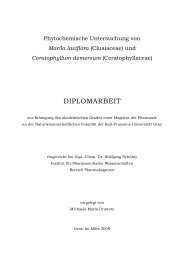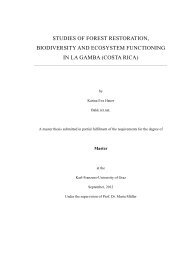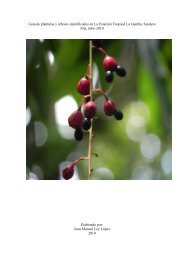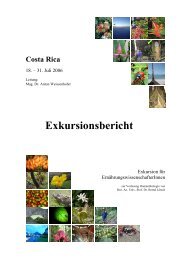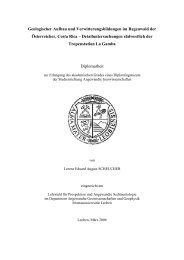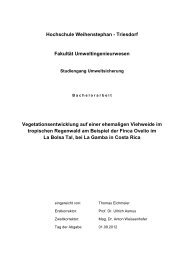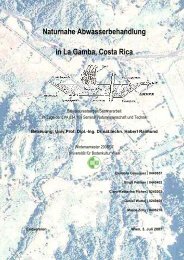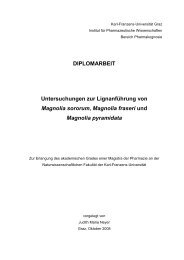Leaf colour patterns, vegetative and sexual reproduction of Episcia ...
Leaf colour patterns, vegetative and sexual reproduction of Episcia ...
Leaf colour patterns, vegetative and sexual reproduction of Episcia ...
You also want an ePaper? Increase the reach of your titles
YUMPU automatically turns print PDFs into web optimized ePapers that Google loves.
p.m. – was made. To avoid scaring <strong>of</strong>f the visitors, a distance <strong>of</strong> several meters was kept. In this<br />
case, binoculars were used for observations.<br />
The visitors were caught with a net. To kill them a piece <strong>of</strong> felt soaked in ethyl acetate was<br />
put with the insects in a plastic container with a screw top. Back in the station the insects were<br />
pinned on needles. Afterwards they were frozen to avoid becoming mouldy or getting eaten up<br />
by ants.<br />
The determination was done with the help <strong>of</strong> Pr<strong>of</strong>essor Vogel <strong>of</strong> the University <strong>of</strong> Vienna<br />
<strong>and</strong> Mag. Dominique Zimmermann (curator <strong>of</strong> the hymenoptera collection) at the Natural<br />
History Museum in Vienna.<br />
Results: A stingless bee (subfamily Meliponinae) was caught. It was observed collecting<br />
pollen. Unfortunately only stingless bees visited the flowers <strong>of</strong> <strong>Episcia</strong> lilacina during the<br />
monitoring. In the vicinity <strong>of</strong> the flowers orchid bees as well as bumblebees could be seen, even<br />
though none <strong>of</strong> them visited the flower <strong>of</strong> <strong>Episcia</strong> lilacina. Additionally, an ant queen <strong>of</strong> the<br />
subfamily Myrmicinae was caught in a net that had been wrapped around a flower.<br />
Discussion: The observations reported in this paper indicate that butterflies (Rhopalocera) –<br />
rather than bees- are the legitimate pollinator <strong>of</strong> <strong>Episcia</strong> lilacina. Sadly, no butterfly visiting the<br />
flower could be seen. During the observations Euglossini were spotted in the vicinity that are<br />
known to visit flowers that are also pollinated by butterflies (Vogel 1966). One important source<br />
<strong>of</strong> nectar for Euglossini are species <strong>of</strong> the family <strong>of</strong> Gesneriaceae (Wiehler 1978). However, none<br />
<strong>of</strong> the observed Apidae species visited the flower <strong>of</strong> <strong>Episcia</strong> lilacina.<br />
The ant queen that was caught in the net was most likely there by chance. No further<br />
observations <strong>of</strong> similar kinds could be made. Thus it is out <strong>of</strong> the question to act as pollinator.<br />
On top <strong>of</strong> the leaves a caterpillar species was found (“Part 1”). Caterpillars are <strong>of</strong>ten seen on<br />
the very same plants they pollinate later on as adult butterfly (Scoble 1995, Proctor et al 1996).<br />
This is not the case here, however. The caterpillar species belongs to the moth <strong>and</strong> in addition is<br />
much too small to be the missing legitimate pollinator. It is definitely possible that the caught<br />
stingless bee is a secondary pollinator (see fig. 29). Anyway, it does not fit the pollination<br />
syndrome <strong>of</strong> <strong>Episcia</strong> lilacina.<br />
The importance <strong>of</strong> particular pollinators to tropical forest plants frequently shifts from year<br />
to year (Roubik et al 2003). Thus even though the legitimate pollinator was not seen during the<br />
observations this year it could possibly be encountered quite easily the next year. Further<br />
observations are absolutely necessary to solve the mystery <strong>of</strong> the pollinator <strong>of</strong> <strong>Episcia</strong> lilacina<br />
entirely.<br />
69



